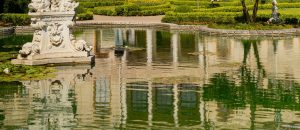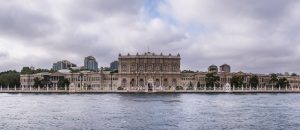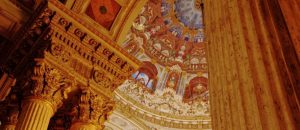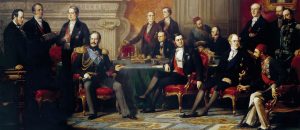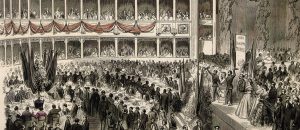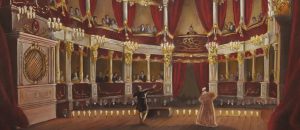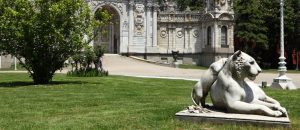Ortaköy Mosque, built during the same period and by the same architects as Dolmabahçe Palace, is a conscious challenge to classical Ottoman mosque architecture. In contrast to the understanding of monumental power, mass weight, and introspective spirituality represented by Mimar Sinan, this mosque, the work of Garabet and Nigoğos Balyan, reflects the changing aesthetics and worldview of the Tanzimat era with its elegance, lightness, and extroverted structure. This structure is the most elegant proof of how radical a revolution the influence of Westernization created, not only in palaces but even in the empire’s most sacred spaces.
Mimar Sinan’s Seal: Power, Symmetry, and the Central Dome
To understand classical Ottoman mosque architecture, one must look at the works of Mimar Sinan. Sinan’s architectural genius is founded upon an overwhelming sense of power, perfect symmetry, and a monumental central dome that gathers the entire space under one roof. In masterpieces like the Süleymaniye or Selimiye Mosques, the dome rests upon gigantic elephant feet (thick load-bearing columns), and the structure rises like an unshakable fortress, seemingly rooted in the earth. The interior space features dim lighting and aims to detach the visitor from the mundane and place them into a spiritual atmosphere. Sinan’s architecture symbolizes the power and permanence of a self-assured empire. [Link: Mimar Sinan’s works and architectural approach -> https://www.unesco.org.tr/Pages/153/126/Mimar-Sinan]
The Balyans’ Challenge: Elegance, Light, and Neo-Baroque
The Balyans’ Ortaköy Mosque (officially named Büyük Mecidiye Mosque) virtually reverses Sinan’s formula. This mosque is an monument of elegance and sophistication, rather than a display of power.
Lightness Instead of Weight: The mosque rises on thin and elegant columns instead of massive load-bearing elements. This gives the structure a light appearance, as if it were gliding on water.
Light Instead of Dimness: Unlike Sinan, the Balyans used colossal windows that cover almost the entire façades of the mosque. These windows carry the constantly changing light and blue of the Bosphorus into the sacred space, blurring the boundaries between the interior and exterior spaces.
Ornamentation Instead of Simplicity, The Dome
Ornamentation Instead of Simplicity: In classical architecture, ornamentation is usually integrated with the structural elements of the building. In Ortaköy Mosque, however, the façade is adorned with acanthus leaves, scallop shells, and intricate carvings, bearing a dynamic Neo-Baroque and Rococo character. This is a reflection of the ornamentation style [Link: in the interior architecture of Dolmabahçe Palace -> /tavanlar-sutunlar-ve-bosluklar-dolmabahcenin-ic-mekan-mimarisi-neden-bir-guc-gosterisidir] applied to religious architecture.
The Dome: From Weight to Lightness: The clearest difference between the two architectural approaches is seen in the dome design. Mimar Sinan’s domes are keystones that collect all the building’s weight and anchor it to the earth. The dome of Ortaköy Mosque, however, gives the impression of virtually floating in the air due to the large windows surrounding its drum. This is the architectural reflection of a new theological interpretation where the divine is expressed not through weight and overwhelming mass, but through lightness and illumination.
Façade and Location: From Fortress to Waterside Pavilion
Mimar Sinan’s mosques are usually like spiritual sanctuaries, isolated from the city’s chaos within a külliye (complex). Their façades convey a solid and protected feeling. Ortaköy Mosque, on the other hand, is located directly on the water’s edge, like a palace or a yalı (waterside mansion), in one of the Bosphorus’s busiest spots. With its colossal windows and elegant stonework, it resembles a waterside pavilion [Link: which is part of the imperial stage of the Bosphorus -> /bogazicinin-sahnesi-balyanlar-istanbulu-nasil-sekillendirdi] rather than a house of worship. This is a radical message showing that religion no longer exists within a fortress isolated from society, but right in the middle of modern life and international traffic.
A Symbol of a Change in Mentality
This architectural contrast between Sinan and the Balyans is not merely a difference in aesthetic taste. It is a reflection of two different imperial mentalities. Mimar Sinan’s works represent a world empire at the peak of its power, self-sufficient, and having created its own aesthetic language. The Balyans’ Ortaköy Mosque, on the other hand, is a symbol of an empire that has turned its face to the West, seeking integration with Europe, and is cosmopolitan and changing. This mosque is an announcement that the Ottoman Empire did not hesitate to display its desire for modernization even in its most sacred space.
Conclusion
In conclusion, Ortaköy Mosque is not a tribute to Mimar Sinan’s classical legacy by the Balyans, but a conscious challenge. By placing elegance instead of power, lightness instead of weight, light instead of dimness, and openness to the world instead of introversion, they built not only a new mosque but also a new imperial vision. This elegant structure stands today as one of the most beautiful reflections of the revolutionary spirit of the Tanzimat era and the growing pains of Westernization cast upon the waters of the Bosphorus.









